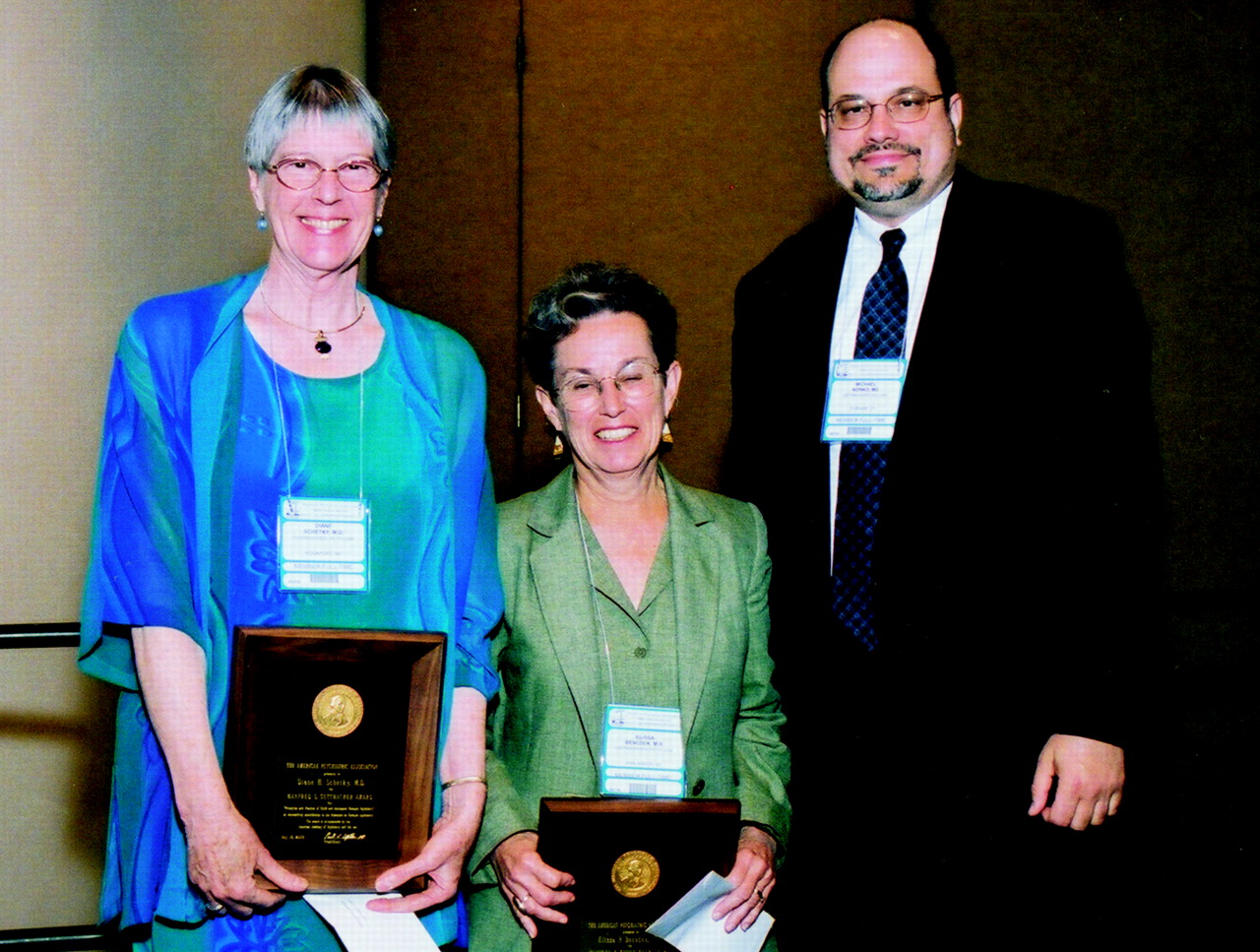False Sex Abuse Accusations Lead to Revision of Theories

Forensic child and adolescent psychiatrists Diane Schetky, M.D. (left), and Elissa Benedek, M.D., receive the Manfred S. Guttmacher Award from Michael A. Norko, M.D., chair of the award committee. They were honored for their book Principles and Practice of Child and Adolescent Forensic Psychiatry, published last year by American Psychiatric Publishing Inc.
“I am amazed at experts who, despite the lack of evidence, continue to rely on a child’s behavior as an indicator of sex abuse,” said Schetky, who has served as an expert witness in numerous cases of alleged child sexual abuse in the last 25 years.
Research has shown that sexualized behavior, for example, can be attributed to a number of other causes, including family sexuality, violence, and hours spent in day care, according to Schetky. Investigators have widely used children’s drawings, diagrams, and anatomically correct dolls to yield information that might support allegations of child sexual abuse.
However, studies have shown that young children may not appreciate the symbolic value of diagrams, adult questioning may influence the content of drawings, and dolls may increase recall but lead to inaccurate reports, said Schetky.
The research was driven primarily by sensational cases of alleged child sexual abuse in day-care centers in the 1980s, said Schetky.
“The public was outraged about the way the investigations were conducted and the ensuing miscarriages of justice that put innocent people in prison,” said Schetky.
The research showed that between 23 percent and 33 percent of child sexual abuse cases involved false allegations, between 2 percent and 8 percent of cases involved deliberate lies by children, and the majority of reported cases were unfounded, said Schetky.
Several forces collided to create this phenomenon, including very young witnesses, inexperienced experts, poorly trained investigators, and role confusion.
“Interviewers were gullible, asked leading questions, conducted multiple interviews that led to delayed disclosures with fantastical details, and failed to consider other explanations for the children’s behaviors,” said Schetky.
Therapists confused the absence of memory with repression of a traumatic memory, believed that memories were immutable and could be recalled from birth, and assumed a person who felt abused had indeed been abused, said Schetky.
Despite the lack of empirical evidence, therapists embraced and testified about various syndromes in court to explain the dynamics of sexual abuse. These included the sexual accommodation syndrome, a theoretical model designed to explain the dynamics of an incestuous family, and the sexually abused child syndrome, said Schetky.
Researchers found that children aged 11 and older were less suggestible than younger children, and preschool children were highly suggestible, said Schetky.
“The most reliable interviewer technique to obtain a narrative history from children was using open-ended questions and the child’s own words,” said Schetky.
Some studies suggested that the first interview with the child is the most accurate, said Schetky.
During the last decade, psychiatrists conducted research on the long-term consequences of child sexual abuse. However, the results have been inconclusive. For example, a large retrospective study of women who were sexually abused in childhood showed a correlation with all psychiatric disorders, but another study on the effects of childhood sexual abuse showed a specific correlation with depression, suicide outcome, and posttraumatic stress disorder, according to Schetky.
The mixed results make predicting long-term outcomes of childhood sexual abuse risky, she concluded.
Judges in federal courts are largely responsible for determining the admissibility of testimony. “The impact of the Supreme Court’s decision in 1993 in Daubert v. Dow was to increase judges’ awareness of scientific methods and concepts of reliability and relevance. The plaintiff (Daubert) lost the case because of conflicting expert testimony from physicians and researchers. The ruling led to the publication of the Judge’s Scientific Reference Manual in 1994,” said Schetky.
The impact of the ruling has been increased scrutiny of expert testimony, particularly in civil cases. “I recently spent a day answering questions from the opposing attorney about the methods and research I used in reaching my opinions,” said Schetky.
“Ethical Guidelines for the Practice of Forensic Psychiatry” is posted on the Web site of the American Academy of Psychiatry and the Law at www.aapl.org/publ.htm. ▪



